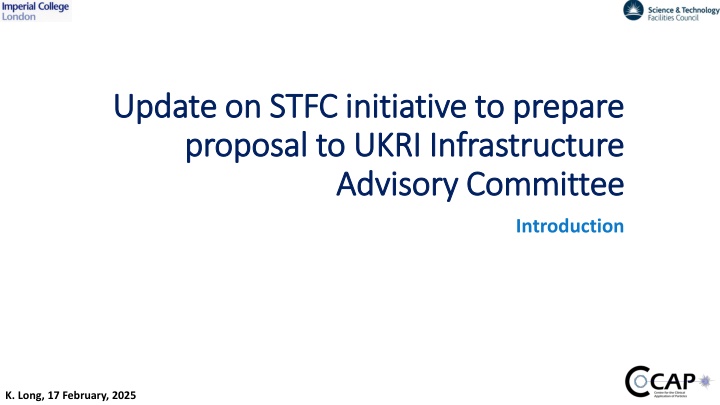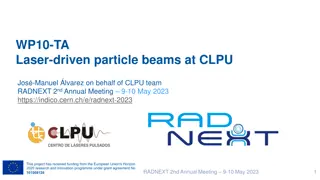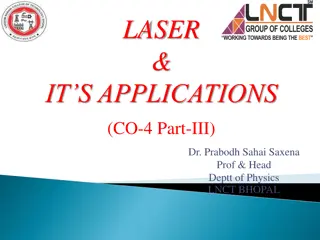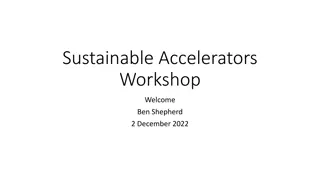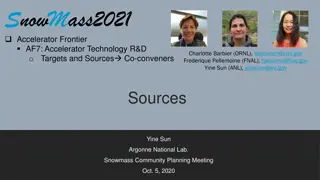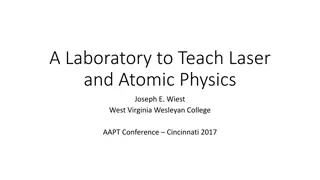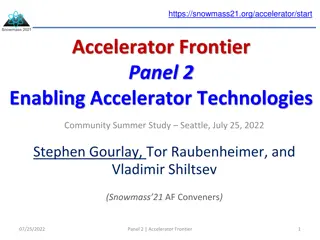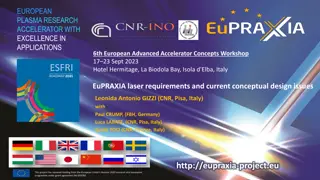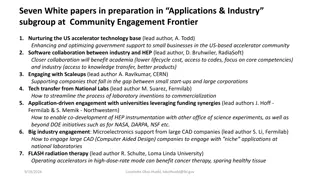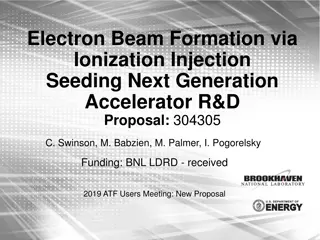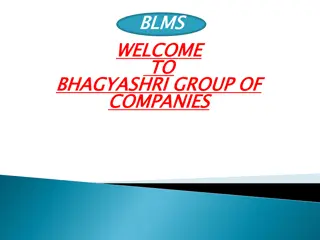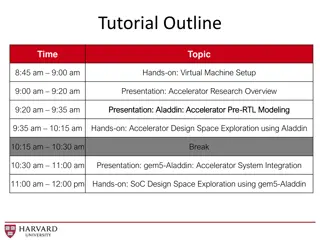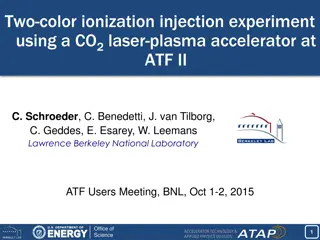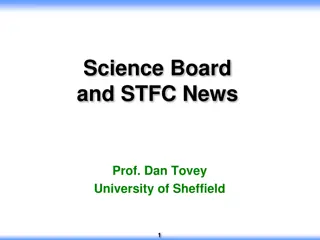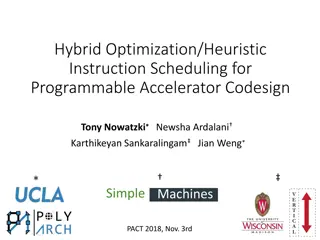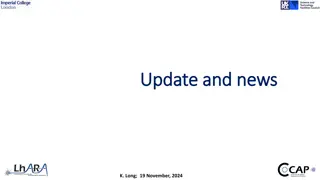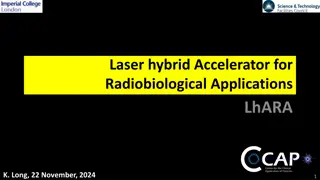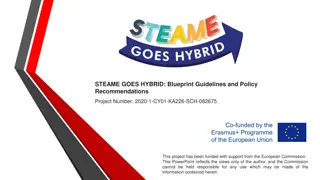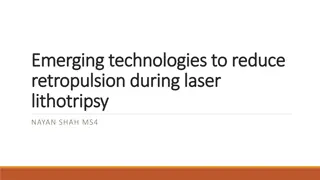STFC Initiative for Laser-hybrid Accelerator for Radiobiological Applications
The STFC is driving the development of a groundbreaking laser-hybrid accelerator, LhARA, for advanced cancer therapy. This initiative aims to revolutionize radiation treatment with cutting-edge technology and research to benefit patients globally."
Uploaded on Feb 17, 2025 | 2 Views
Download Presentation

Please find below an Image/Link to download the presentation.
The content on the website is provided AS IS for your information and personal use only. It may not be sold, licensed, or shared on other websites without obtaining consent from the author.If you encounter any issues during the download, it is possible that the publisher has removed the file from their server.
You are allowed to download the files provided on this website for personal or commercial use, subject to the condition that they are used lawfully. All files are the property of their respective owners.
The content on the website is provided AS IS for your information and personal use only. It may not be sold, licensed, or shared on other websites without obtaining consent from the author.
E N D
Presentation Transcript
Update on STFC initiative to prepare Update on STFC initiative to prepare proposal to UKRI Infrastructure proposal to UKRI Infrastructure Advisory Committee Advisory Committee Introduction K. Long, 17 February, 2025
There are two initiatives There are two initiatives LhARA: input to STFC Science, Planning, & Communication Directorate: Initiative of Charlotte Jamieson: Head of Particle Physics, Programmes Directorate, STFC Wrote the draft Visions document
LhARA LhARA for Visions for Visions SCIENCE & TECHNOLOGY FACILITIES COUNCIL STFC Visions Process Guidance for Participants Updated: 07 October 2020 ANNEX 1 Visions proforma Section One: Initial Remit Check ANNEX 2 Visions proforma Section Two: Wider Context & Additional Details ANNEX 1 SCIENCE & TECHNOLOGY FACILITIES COUNCIL STFC Visions Programme Proforma Last Modified: 07 October 2020 Version 1.0 1. CONTEXT The Visions programme is an addition to STFC s suite of tools, designed to encourage and develop ideas that could not otherwise be accommodated by STFC s budgets and processes. The programme aims to allow ideas to be submitted to STFC in a format that initially entails a comparatively short written statement, with more detail being requested for those ideas that are prioritised for further development. STFC welcomes submissions across all areas of our core programme. Visions process: Generated to meet STFC need for a vehicle to develop new, ambitious projects to fundable level ; Unclear whether it is a route to resource; Probably a route to support to develop robust, fundable proposal SECTION ONE: INITIAL REMIT CHECK Idea Title The Laser-hybrid Accelerator for Radiobiological Applications (LhARA) Originator(s) and Institution(s)/Contact Information Charlotte Jamieson Programmes Directorate charlotte.jamieson@stfc.ukri.org Ken Long, Imperial College, K.Long@imperial.ac.uk Abstract (50 words) Use this section to briefly describe the concept to a non-expert (elevator pitch). LhARA is a unique approach to creating a machine for radiation therapy that uses a novel laser-driven system to create proton and ion beams, focused by a plasma (Gabor) lens, followed by a Fixed Field Accelerator. It will be both a prototype and facility to study the potential clinical use of different beams for cancer therapy. Vision Aims & Objectives (400 words) Clearly outline the Vision and aims. Ensure that you highlight the ambition, significance, and excitement of the idea. Cancer is a worldwide issue with a significant, growing impact and economic cost affecting both developed and developing countries alike. LhARA offers STFC an opportunity to harness the knowledge and skills of the accelerator communities that underpin its frontier science programme and National Laboratory facilities allowing the UK to take the lead in tackling this global health challenge. Radiotherapy using photon or electron beams remains an indispensable stalwart in effectively and cheaply treating patients. More recently proton and ion treatments allow a more targeted beam delivery with less surrounding tissue damage. LhARA is a novel machine that takes this further presenting the exciting possibility of a cheaper, more flexible system. It allows study of the physical characteristics of different beams and how they affect the biological response to radiation treatments as well as the development of a prototype treatment facility. LhARA uses a non-nuetral (electron) plasma (Gabor) lens to capture and focus a laser- accelerated beam of protons or ions that are further accelerated using a fixed field alternating (FFA) gradient. This unique combination offers advantages over traditional systems; the laser-driven source captures protons and ions at higher energies, the Gabor lens focuses this beam more cheaply than the usual solenoid set up and the rapid acceleration from the FFA maintains the integrity of the beam structure delivered by the source. The net effect is a flexible system capable of delivering a high instantaneous dose equivalent to over 109 Gy/s in a short pulse and tiny area, ~1mm compared to a conventional system that delivers <10 Gy/min over a large area. LhARA will be delivered in 2 stages. The first includes the laser source, Gabor lenses and bending magnets. This allows studies of biological samples increasing our understanding of the cell mechanisms that underlie these treatments. The second adds the FFA and Explicitly, this programme is not a replacement for STFC s core science programme. It also does not seek to replace or circumvent business as usual arrangements for creating, developing, and prioritising projects or proposals within STFC s national laboratories or a specific research community. The Visions process is designed to support the development of an idea from its original conception into a compelling business case. Proposals entering this process will move through stage gates, designed to ensure a good fit to the programme remit and high competitiveness. Throughout this process, the STFC Visions implementation group will work with the originator to develop the Visions narrative, with the intention of supporting a targeted submission into a relevant funding channel. The course to identifying Vision concepts will remain highly competitive throughout due to limited capacity and resource to support a high volume of prospective candidates. There may be opportunities to redirect Visions submitted into this process through other funding or delivery mechanisms within STFC. 2. VISIONS PROGRAMME OBJECTIVES This programme aims to: solicit and review highly ambitious ideas of significant financial scale from the STFC community create a pool of suitable ideas stored by STFC, awaiting further development and eventual targeting towards strategic funding opportunities build a robust process by drawing upon learning from previous approaches within STFC and URKI partners
Visions review of Visions review of LhARA LhARA submission submission Panel: Chair: Dr. Bryony Butland, STFC UK Research and Innovation Infrastructure roadmap lead Membership: When: 06May21; 15:00 Representation: Charlotte Jamieson, KL Decision: only two representatives per proposal 10 minute slot to answer questions
There are two initiatives There are two initiatives LhARA: input to STFC Science, Planning, & Communication Directorate: Initiative of Charlotte Jamieson: Head of Particle Physics, Programmes Directorate, STFC Wrote the draft Visions document Ion Therapy Research Facility (ITRF): Proposal for Preliminary Activity as part of STFC Visons process 2M over 2 years to develop full infrastructure proposal Possible bid to UKRI Infrastructure Advisory Panel Initiative of: Jim Clarke (Director ASTeC) and David Newbold (Director, PPD) Champion at STFC Executive Board level : Paul Vernon (Executive Director, Business and Innovation) Named leads: Jim Clarke Massimo Noro (Business Development Director, Science and Technology at STFC) Authors of submission: Clarke, Long, Noro, Hywel Owen (Accelerator Physics Group Leader, ASTeC, STFC)
ITRF for Visions; aimed at UKRI IAC ITRF for Visions; aimed at UKRI IAC Please submit your Preliminary Project Submission Form by the 16th April 2021 to Ailidh.Woodcock@stfc.ukri.org and Eleanor.Lech@stfc.ukri.org Name of Project Ion Therapy Research Facility (ITRF) Preliminary Project Submission Form 2021 Select one from: [ X ] establishing new capability, [ ] significant change to existing capability e.g. upgrade, [ ] combination of new and changes to existing, [ ] decommissioning, [ ] unknown Massimo Noro (massimo.noro@stfc.ac.uk) In collaboration with: Jim Clarke (jim.clarke@stfc.ac.uk) Type of infrastructure the preliminary activity is working towards Lead contact Advisory Board being set up Support from: International Biophysics Collaboration Discussions with, e.g. MRC Invited for interview: Likely representatives: Noro, Clarke One-line description of the new capability delivered by the Project We will construct an ITRF that will elucidate the biology and biochemistryof proton and heavier ion beams therapy using new technologies necessary to transform cancer treatment. [28 words] Summary of the Preliminary Activity Objectives: We propose to establish the Ion Therapy Research Facility to deliver the world-leading, multidisciplinary programme necessary to: Deliver the measurements required to elucidate the biological and biochemical mechanisms that underpin the clinical efficacy of proton- and ion-beam therapy; Demonstrate the disruptive accelerator, diagnostic, imaging, and computing technologies required to radically transform clinical practice in proton- and ion- (particle-) beam therapy (PBT) by creating a compact, fully automated, highly flexible system; and Create the capability to deliver proton- and ion-beam therapy in completely new regimens by combining a variety of ion species, from proton to neon, in a single treatment fraction exploiting ultra-high dose rates and novel spectral-, spatial- and temporal-fractionation schemes. The establishment of the ITRF will place the UK at the forefront of the science and technology of particle therapy for cancer, establish UK industry as a key player in the delivery of novel clinical equipment, and enable significantly enhanced access to state-of-the-art PBT across the UK. The ITRF will enhance the UK as the destination of choice for cutting-edge research. Radiation therapy using ions (He, C, N, O and Ne) is recognised as an important modality to address the unmet need for cancer treatment in a number of patient cohorts that today have poor outcomes, especially those with hard to treat tumours. The ITRF will deliver flexible, well-characterised beams at high dose rate in a wide range of ions, to enable transformative research to optimise the treatment methods of the future. It will also serve to deliver a step change in technology that makes future ion therapy treatment cheaper and more capable, particularly to deliver novel, high dose rate treatments. In this Preliminary Activity we will develop the detailed specification and design of the ITRF, evaluate its cost, and review and elaborate the first phase of the ITRF research programme. The principal deliverable will be a full Conceptual Design Report (CDR) for the facility. Management of the Preliminary Activity: A series of scoping workshops and a position paper have identified the general requirements for the ITRF. To establish the detailed specification for the ITRF and to provide stakeholder oversight throughout the Preliminary 1
Update since 27Apr21 Update since 27Apr21 LhARA LhARA meeting meeting Discussion, 28Apr21: Clarke, Jamieson, Long, Noro, Owen: Agreed thrust was to drive a step change; anyone can make increment LhARA vision as high-risk, high-return long-term ambition Recognised as generating benefit through lab/academe/international/industry ITRF interview: 29Apr21: Noro, Owen: From: Kenneth Long ken.long@stfc.ac.uk Subject: Fwd: Alignment in preparation to STFC Visions interviews (ITRF and LhARA) Date: 29 April 2021 at 13:01 To: Begin forwarded message: From: "Noro, Massimo (STFC,DL,BID)" <massimo.noro@stfc.ac.uk> Subject: Re: Alignment in preparation to STFC Visions interviews (ITRF and LhARA) Date: 29 April 2021 at 09:02:10 BST To: "Long, Ken (Imperial Coll.,RAL,PPD)" <ken.long@stfc.ac.uk>, "Owen, Hywel (STFC,DL,AST)" <hywel.owen@stfc.ac.uk> Cc: "Clarke, Jim (STFC,DL,AST)" <jim.clarke@stfc.ac.uk>, "Jamieson, Charlotte (STFC,SO,PROG)" <Charlotte.Jamieson@stfc.ukri.org> It went well. About 15 min of pointy questions, which Hywel and I handled as a tag- team: I took the more general ones on strategy and approach and Hywel the more specific ones on technology. By memory, the questions asked where: - research program - engagement plans - detailed breakdown of costs - which technologies - is Government supportive of ion treatment ... (Hywel, did you manage to write down more?) Good idea to discuss both questions and answers. Our diaries look promising on Tuesday morning, for a debrief. I will send out a meeting request. Best, Massimo From: "Long, Ken (Imperial Coll.,RAL,PPD)" <ken.long@stfc.ac.uk> Date: Thursday, 29 April 2021 at 08:48 To: Massimo Noro <massimo.noro@stfc.ac.uk>, "Owen, Hywel (STFC,DL,AST)" <hywel.owen@stfc.ac.uk> Cc: "Clarke, Jim (STFC,DL,AST)" <jim.clarke@stfc.ac.uk>, "Jamieson, Charlotte (STFC,SO,PROG)" <Charlotte.Jamieson@stfc.ukri.org> Subject: Re: Alignment in preparation to STFC Visions interviews (ITRF and LhARA) Hi how d it go and should we schedule a debrief? Ken On 22 Apr 2021, at 09:56, Noro, Massimo (STFC,DL,BID) <massimo.noro@stfc.ac.uk> wrote: Thanks, Ken. That s a very good idea. Charlotte, I will forward you the outlook invite for next week. Best, Massimo From: "Long, Ken (Imperial Coll.,RAL,PPD)" <ken.long@stfc.ac.uk>
